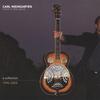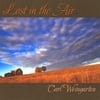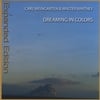My grandfather, George Eveleth, was eight years old
when he and his family survived the 1906 San Francisco earthquake. Their house
was also spared, and on that day, George sat on the front steps watching the
parade of refugee’s stream by on their way to the tent city in Golden Gate
Park. His father left that morning and when he returned, he brought with him
two items - an antique clock and a banjo. George took up the banjo and by the
time he was in high school, he was playing professionally. Along the way he met
and was mentored by a local percussionist and bandleader named Art Hickman.
My mother has spoken of my grandfather many times over
the years, but the significance of George’s connection to Art Hickman never
occurred to me until recently. Hickman was a historic figure in the early days
of jazz. San Francisco based, he helped not only pioneer jazz orchestras, but
incorporated the use of multiple saxophones, having them play in harmony, and
above the trumpets - a signature jazz arrangement. Hickman’s music is difficult
to label, though perhaps described as a mix of Ragtime and Dixieland. Hickman
didn’t consider his compositions to be so much jazz as it was primarily dance
music. In 1913 The Art Hickman Orchestra was an established regional act, and
became the first jazz band to play the prestigious Mural Room at The St.
Francis Hotel. The run lasted for a decade. In 1919 Art Hickman’s band was
invited to New York, where Hickman signed a contract with Columbia Records.
National success quickly followed and lasted until Hickman’s death in 1930.
For a time during this period, my grandfather was in
Hickman's circle of musicians. Whether George was ever an official band member,
we don't know, but he did perform with Hickman at The St. Francis on a number
of occasions. During the First World War George served in the Merchant Marines,
and upon his release, he returned to playing music for a living. But as much as
George loved being a performer, and the nightlife that came with it, music
would soon become his lifestyle rather than his profession. “The only musicians
earning a good living are session musicians” he told once my mother. George
wanted to have a family and to play music locally. He entered college in 1923
and graduated from UCSF Medical School.
I was too young to really know my grandfather. He died
in 1964. Our family lived in the Midwest and rarely visited. I do have a few
memories, including watching George play banjo and sing at a Christmas party.
After he died, George’s second wife changed his will to exclude my mother and
aunt. Also against my grandfather’s wishes, she sold his instruments and
otherwise liquidated his estate. Recently my mother showed me one of my
grandfather’s few remaining possessions – an album of family photographs from
roughly 1900 through the 1950s. Among them are several photos of my grandfather
playing banjo or guitar, nearly all taken later in life with family and
friends. However three photographs placed on the opening page, stand out as
special. The first is a studio portrait of a smiling, youthful and smartly
dressed George Eveleth. The second photo is also a portrait, that of another
man, slightly older than George. The identical lighting and background of these
two photos suggests they were taken at the same location. My mother pointed to
the second photo and said, “My father always insisted that was Art Hickman”.
Hickman was ten years older than my grandfather, and I’ve tried to verify this
image, but photos of Art Hickman are rare. Assuming the man in the portrait
photo is Hickman, as my grandfather had said, he appears very young as compared
to the man in official publicity photos and record sleeves.
The third photo shows a vintage jazz orchestra posing
for the camera against a backdrop. There are eight musicians; two banjos, one
violin, bass, saxophone, trombone and accordion players. A ninth man stands in
the back row with his hands at his side. The photo is only a few inches wide,
is creased and unevenly cut, perhaps trimmed from a larger print. Fortunately
as an original photo, it's sharp enough that a digital scan revealed more
detail. Seated in the middle, posing with his banjo and with an
uncharacteristically serious expression is my grandfather. He appears to be in
his late teens. The other musicians are a mystery. At some point I hope to ID
some of their faces, and perhaps verify if any or all were part of Hickman’s
Orchestra. If so it would confirm my grandfather’s place and time during the
early days of jazz.
I’ve restored this photo as a Christmas gift to my
mother. Here is the before and after.








No comments:
Post a Comment